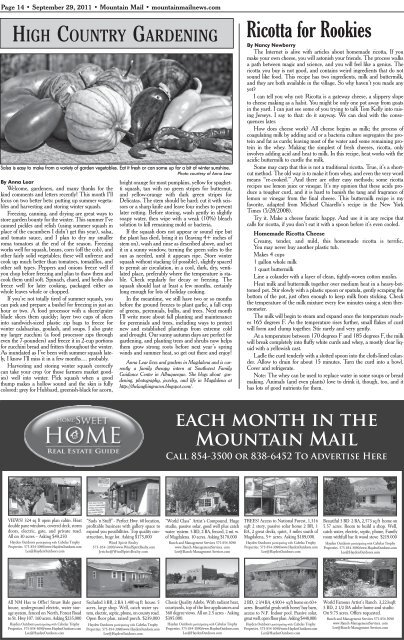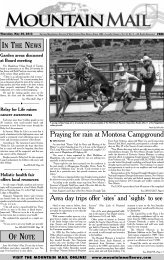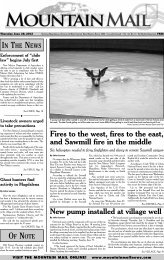Oktoberfest celebrates 20 years - Mountain Mail News
Oktoberfest celebrates 20 years - Mountain Mail News
Oktoberfest celebrates 20 years - Mountain Mail News
You also want an ePaper? Increase the reach of your titles
YUMPU automatically turns print PDFs into web optimized ePapers that Google loves.
Page 14 • September 29, <strong>20</strong>11 • <strong>Mountain</strong> <strong>Mail</strong> • mountainmailnews.com<br />
HIGH COUNTRY GARDENING<br />
Salsa is easy to make from a variety of garden vegetables. Eat it fresh or can some up for a bit of winter sunshine.<br />
Photo courtesy of Anna Lear<br />
By Anna Lear<br />
Welcome, gardeners, and many thanks for the<br />
kind comments and letters recently! This month I’ll<br />
focus on two better bets: putting up summer vegetables<br />
and harvesting and storing winter squash.<br />
Freezing, canning, and drying are great ways to<br />
store garden bounty for the winter. This summer I’ve<br />
canned pickles and relish (using summer squash in<br />
place of the cucumbers I didn’t get this year), salsa,<br />
and tomato sauce, and I plan to dry my smaller<br />
roma tomatoes at the end of the season. Freezing<br />
works well for squash, beans, corn (off the cob), and<br />
other fairly solid vegetables; these will unfreeze and<br />
cook up much better than tomatoes, tomatillos, and<br />
other soft types. Peppers and onions freeze well if<br />
you chop before freezing and plan to thaw them and<br />
cook them until soft. Spinach, chard, and herbs also<br />
freeze well for later cooking, packaged either as<br />
whole leaves whole or chopped.<br />
If you’re not totally tired of summer squash, you<br />
can pick and prepare a bushel for freezing in just an<br />
hour or two. A food processor with a slicer/grater<br />
blade slices them quickly; layer two cups of slices<br />
into sandwich-sized plastic zip bags to freeze for<br />
winter calabacitas, goulash, and soups. I also grate<br />
my larger zucchini (a food processor zips through<br />
even the 7-pounders) and freeze it in 2-cup portions<br />
for zucchini bread and fritters throughout the winter.<br />
As inundated as I’ve been with summer squash lately,<br />
I know I’ll miss it in a few months… probably.<br />
Harvesting and storing winter squash correctly<br />
can take your crop (or those farmers market goodies)<br />
well into winter. Pick squash when a good<br />
thump makes a hollow sound and the skin is fully<br />
colored: grey for Hubbard, greenish-black for acorn,<br />
bright orange for most pumpkins, yellow for spaghetti<br />
squash, tan with no green stripes for butternut,<br />
and yellow-orange with dark green stripes for<br />
Delicatas. The stem should be hard; cut it with scissors<br />
or a sharp knife and leave four inches to prevent<br />
later rotting. Before storing, wash gently in slightly<br />
soapy water, then wipe with a weak (10%) bleach<br />
solution to kill remaining mold or bacteria.<br />
If the squash does not appear or sound ripe but<br />
the plant has died, bring it in (leaving 4+ inches of<br />
stem on), wash and rinse as described above, and set<br />
it in a sunny window, turning the green sides to the<br />
sun as needed, until it appears ripe. Store winter<br />
squash without stacking (if possible), slightly spaced<br />
to permit air circulation, in a cool, dark, dry, ventilated<br />
place, preferably where the temperature is stable.<br />
Check regularly for decay or freezing. The<br />
squash should last at least a few months, certainly<br />
long enough for lots of holiday cooking.<br />
In the meantime, we still have two or so months<br />
before the ground freezes to plant garlic, a fall crop<br />
of greens, perennials, bulbs, and trees. Next month<br />
I’ll write more about fall planting and maintenance<br />
for perennials and trees, including ways to protect<br />
new and established plantings from extreme cold<br />
and drought. Our sunny autumn days are perfect for<br />
gardening, and planting trees and shrubs now helps<br />
them grow strong roots before next year’s spring<br />
winds and summer heat, so get out there and enjoy!<br />
Anna Lear lives and gardens in Magdalena and is currently<br />
a family therapy intern at Southwest Family<br />
Guidance Center in Albuquerque. She blogs about gardening,<br />
photography, jewelry, and life in Magdalena at<br />
http://thelaughingraven.blogspot.com/.<br />
Ricotta for Rookies<br />
By Nancy Newberry<br />
The Internet is alive with articles about homemade ricotta. If you<br />
make your own cheese, you will astonish your friends. The process walks<br />
a path between magic and science, and you will feel like a genius. The<br />
ricotta you buy is not good, and contains weird ingredients that do not<br />
sound like food. This recipe has two ingredients, milk and buttermilk,<br />
and they are both available in the village. So why haven’t you made any<br />
yet<br />
I can tell you why not: Ricotta is a gateway cheese, a slippery slope<br />
to cheese making as a habit. You might be only one pot away from goats<br />
in the yard. I can just see some of you trying to talk Tom Kelly into raising<br />
Jerseys. I say to that: do it anyway. We can deal with the consequences<br />
later.<br />
How does cheese work All cheese begins as milk; the process of<br />
coagulating milk by adding acid or a bacteria culture segregates the protein<br />
and fat as curds; leaving most of the water and some remaining protein<br />
in the whey. Making the simplest of fresh cheeses, ricotta, only<br />
involves adding acid and heat to milk. In this recipe, heat works with the<br />
acidic buttermilk to curdle the milk.<br />
Some may carp that this is not a traditional ricotta. True, it’s a shortcut<br />
method. The old way is to make it from whey, and even the very word<br />
means “re-cooked.” And there are other easy methods; some ricotta<br />
recipes use lemon juice or vinegar. It’s my opinion that these acids produce<br />
a tougher curd, and it is hard to banish the tang and fragrance of<br />
lemon or vinegar from the final cheese. This buttermilk recipe is my<br />
favorite, adapted from Michael Chiarello’s recipe in the New York<br />
Times (5/28/<strong>20</strong>08).<br />
Try it. Make a cheese fanatic happy. And use it in any recipe that<br />
calls for ricotta, if you don’t eat it with a spoon before it’s even cooled.<br />
Homemade Ricotta Cheese<br />
Creamy, tender, and mild, this homemade ricotta is terrific.<br />
You may never buy another plastic tub.<br />
Makes 4 cups<br />
1 gallon whole milk<br />
1 quart buttermilk<br />
Line a colander with a layer of clean, tightly-woven cotton muslin.<br />
Heat milk and buttermilk together over medium heat in a heavy-bottomed<br />
pot. Stir slowly with a plastic spoon or spatula, gently scraping the<br />
bottom of the pot, just often enough to keep milk from sticking. Check<br />
the temperature of the milk mixture every few minutes using a stem thermometer.<br />
The milk will begin to steam and expand once the temperature reaches<br />
165 degrees F. As the temperature rises further, small flakes of curd<br />
will form and clump together. Stir rarely and very gently.<br />
At a temperature between 170 degrees F and 185 degrees F, the milk<br />
will break completely into fluffy white curds and whey, a mostly clear liquid<br />
with a yellowish cast.<br />
Ladle the curd tenderly with a slotted spoon into the cloth-lined colander.<br />
Allow to drain for about 15 minutes. Turn the curd into a bowl.<br />
Cover and refrigerate.<br />
Note: The whey can be used to replace water in some soups or bread<br />
making. Animals (and even plants) love to drink it, though, too, and it<br />
has lots of good nutrients for them.<br />
each month in the<br />
<strong>Mountain</strong> <strong>Mail</strong><br />
Call 854-3500 or 838-6452 To Advertise Here<br />
VIEWS! 324 sq ft open plan cabin. Heat<br />
double pane windows, covered deck, storm<br />
doors, electric, gate, and private road.<br />
All on 30 acres – Asking $49,250<br />
Hayden Outdoors participating with Cabelas Trophy<br />
Properties. 575-854-3090/www.HaydenOutdoors.com<br />
Lee@HaydenOutdoors.com<br />
“Suds ‘n Stuff” - Perfect Hwy. 60 location,<br />
profitable business with gallery space to<br />
expand you possibilities. Top quality construction,<br />
huge lot. Asking $175,000<br />
Wind Spirit Realty<br />
575-854-3090/www.WindSpiritRealty.com<br />
Jericho@WindSpiritRealty.com<br />
“World Class” Artist’s Compound. Huge<br />
studio, passive solar, good well plus catch<br />
water system. 3 BD, 2 BA, fenced, 2 mi. w.<br />
of Magdalena. 10 acres. Asking $178,000<br />
Ranch and Management Services 575-854-3090<br />
www.Ranch-ManagementServices. com<br />
Lee@Ranch-Management Services.com<br />
TREES! Access to National Forest, 1,316<br />
sqft 2 story, passive solar home 2 BR, 1<br />
BA, 2 great decks, quiet, 3 miles south of<br />
Magdalena, 5+ acres. Asking $189,000.<br />
Hayden Outdoors participating with Cabelas Trophy<br />
Properties. 575-854-3090/www.HaydenOutdoors.com<br />
Lee@HaydenOutdoors.com<br />
Beautiful 3 BD 2 BA, 2,573 sq ft home on<br />
5.57 acres. Room to build a shop. Well,<br />
catch water, electric, septic, phone, Family<br />
room withfull bar & wood stove $219.000<br />
Hayden Outdoors participating with Cabelas Trophy<br />
Properties. 575-854-3090/www.HaydenOutdoors.com<br />
Lee@HaydenOutdoors.com<br />
All NM Has to Offer! Straw Bale guest<br />
house, underground electric, water storage<br />
system, fenced on North, Forest Road<br />
to St. Hwy 107. 160 acres. Asking $235,000<br />
Hayden Outdoors participating with Cabelas Trophy<br />
Properties. 575-854-3090/www.HaydenOutdoors.com<br />
Lee@HaydenOutdoors.com<br />
Secluded 3 BR, 2 BA 1,400 sq ft house. 5<br />
acres, large shop. Well, catch water system,<br />
electric, septic, phone, on county road.<br />
Open floor plan, raised porch. $239,000<br />
Hayden Outdoors participating with Cabelas Trophy<br />
Properties. 575-854-3090/www.HaydenOutdoors.com<br />
Lee@HaydenOutdoors.com<br />
Classic Quality Adobe. With radiant heat,<br />
courtyards, top of the line applicances and<br />
360 degree views. All on 2.5 acres - Asking<br />
$395,000.<br />
Hayden Outdoors participating with Cabelas Trophy<br />
Properties. 575-854-3090/www.HaydenOutdoors.com<br />
Lee@HaydenOutdoors.com<br />
2 BD, 2 3/4 BA, 4,900+ sq ft home on 60+<br />
acres. Beautiful grnds with horse/ hay barn,<br />
access to N.F. Indoor pool. Passive solar,<br />
great well, open floor plan. Asking $448,000.<br />
Hayden Outdoors participating with Cabelas Trophy<br />
Properties. 575-854-3090/www.HaydenOutdoors.com<br />
Lee@HaydenOutdoors.com<br />
World Famous Artist’s Ranch. 3,223sqft<br />
3 BD, 2 1/2 BA adobe home and studio<br />
On 9.75 acres. Offers requested.<br />
Ranch and Management Services 575-854-3090<br />
www.Ranch-ManagementServices. com<br />
Lee@Ranch-Management Services.com










